One of the things I love about football is how the game requires both physical and intellectual elements for success. The physical part is pretty obvious. The team with the best athletes usually wins. The intellectual element is less obvious, but equally important. Think about even the most basic run play in a Division 1 playbook. Before the play gets into the playbook, coaches will spend hours designing it and making sure it has multiple permeations to address the myriad of potential defensive looks the opposition will provide. Once it is in the playbook, coaches spend even more time ensuring the players understand the play and the various ways it can evolve based on what the defense does. On the practice field, drills are designed to teach the skills necessary to execute the play. Once the necessary skills are in place, the play is practiced over and over again until it is perfected.
On game day intellectual components have to be in place for the play to have a reasonable chance of success. For example, the offensive coordinator must call the play at the correct time and in the correct situation. The play then has to be communicated to the players so they know what to do. The players must understand their individual responsibilities (and often the responsibilities of others) and be able to adjust those responsibilities at a moment’s notice if the defense changes. Of course, even if you call the right play and everyone knows what to do, you still have to execute the play. That’s where the physical component comes in.
We’re going to step into the 18 Stripes film room to take a look at a play from 2015 where design, execution and physical ability were successfully integrated to create a big play for the Fighting Irish. Let’s take a look at the film and I’ll show you what I mean.
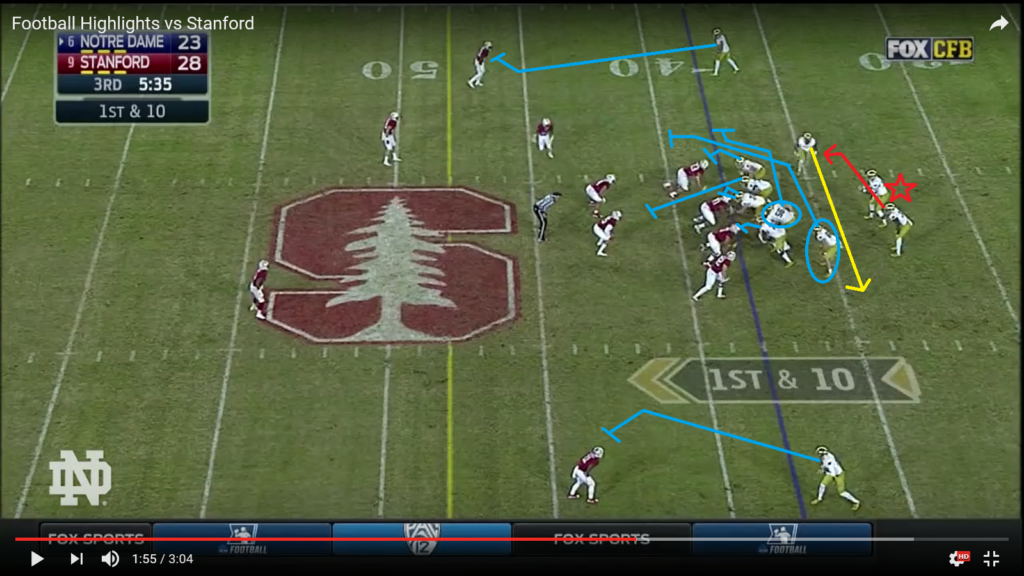
In many ways this is a pretty standard run play. Josh Adams (# 33, red star) will get the ball and follow the red arrow. Most of the blockers will take on the nearest defender (blue lines). Quenton Nelson (# 56) and Nic Weishar (# 82) will pull across the formation and become lead blockers (blue circles, blue lines). One additional twist, Torii Hunter Jr. (# 16) will motion across the formation and fake the sweep in the opposite direction.
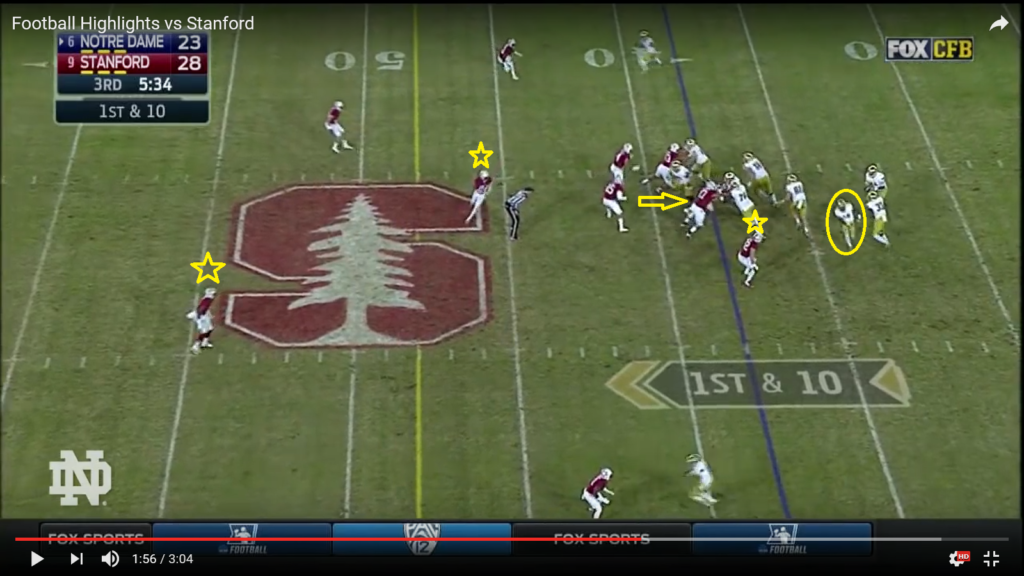
This is a great example of the impact good play design can have. At this point, the fake sweep by Torii Hunter Jr. (yellow circle), has occupied 3 defenders (yellow stars). Although the fake won’t hold them for the entire play, it forces the defenders to hesitate (this will be important later). As a side note, take a look at the defensive end (yellow arrow). At this point he is headed in the direction of the play and is actually in decent position. That won’t last long.
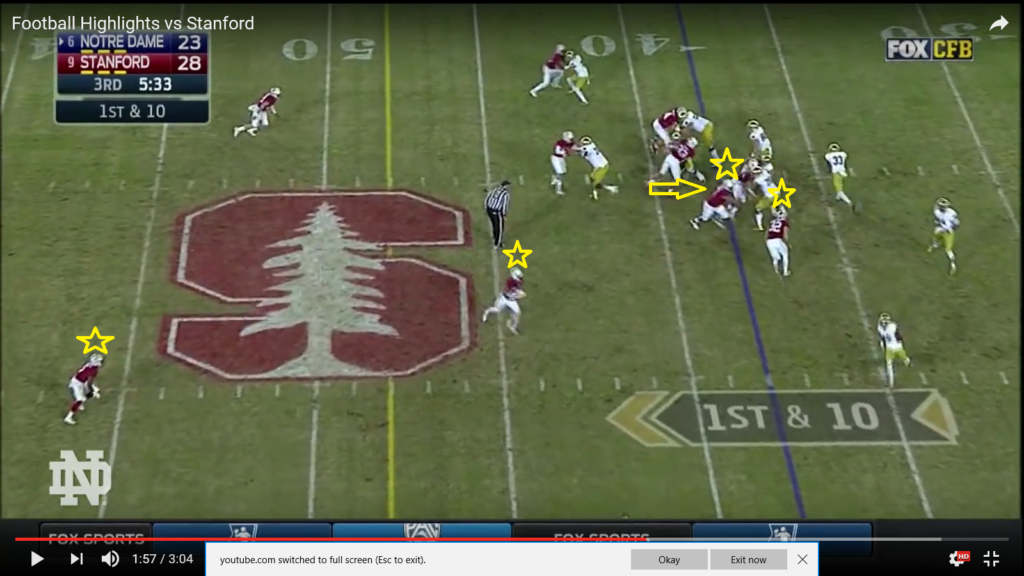
The defensive end (yellow star, yellow arrow), has stopped pursuing the ball carrier and has been pulled in the wrong direction. At this point he seems to be looking at quarterback Deshone Kizer (# 14). That’s 4 defenders pulled away from the ball carrier by play design. Pretty darn good.
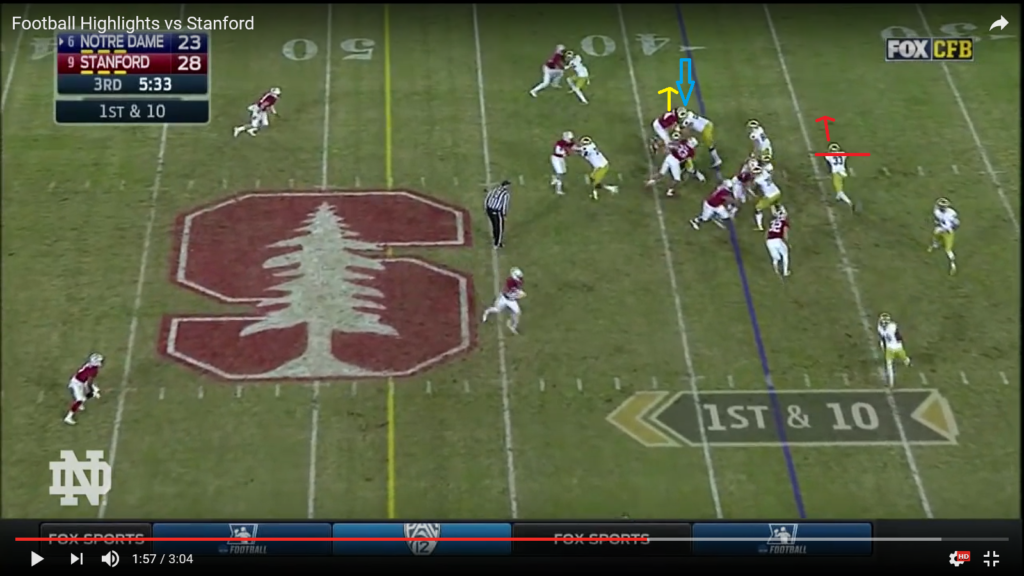
Adams has been coached to stretch the play towards the sidelines before he makes a cut (red arrow). If done properly, this “stretching” creates seams in the defense which the ball carrier can exploit. The key from a running back perspective is to keep your shoulders facing the sidelines (red line) until a seam opens up.
This stretching also helps the offensive linemen. At this point Quenton Nelson (blue arrow) is in a stalemate position with the linebacker. Because Adams is threatening the perimeter, the linebacker will have to move to the outside (yellow arrow), which should allow Nelson to get the advantage.
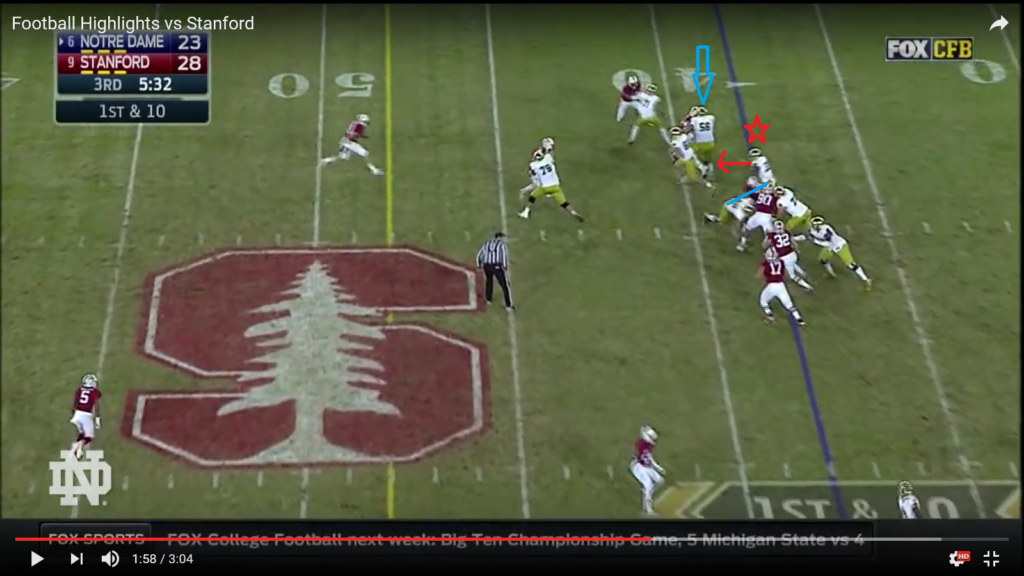
The line has done a nice job of sealing the inside pursuit (blue line), so Adams can turn up field (red star, red arrow). On the perimeter, Nelson now has the advantage and is in excellent position to wall off the defender (blue arrow).
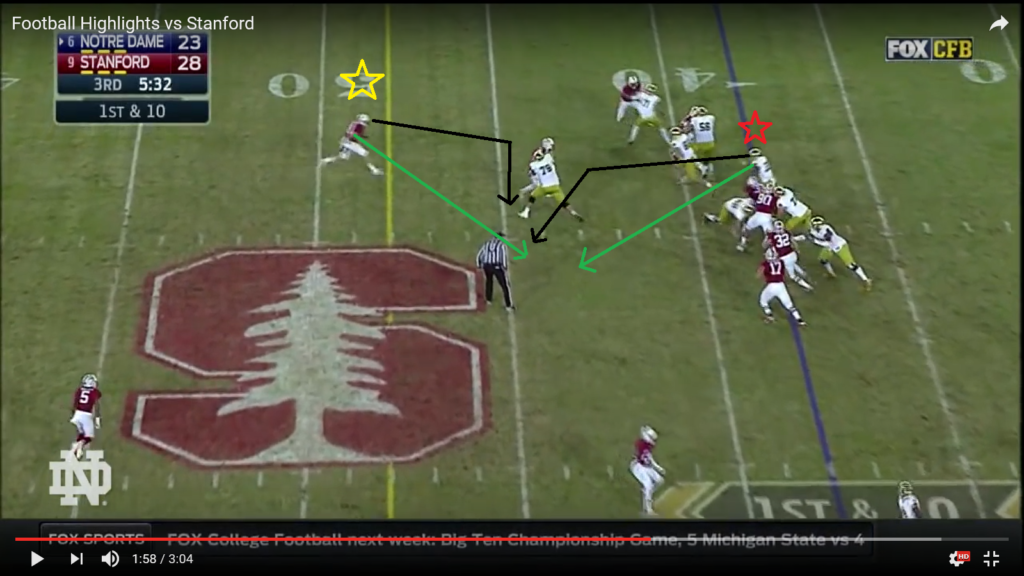
Obviously, there is a lot of space to the left of Adams (red star). The natural tendency would be to run towards that open space immediately, following the green line. In high school this likely would have worked because Adams was so advanced physically. However, you aren’t going to “out” athlete a quality opponent like Stanford. If Adams follows the green arrow, the safety (yellow star) will be able to take a direct line to make the tackle (green line). This would be a pretty easy tackle for a Division 1 safety.
Instead Adams is going to use his intellect and be patient. He will follow the black line and wait until the last possible moment to make the cut. By taking this approach, the safety will have to continue moving forward (black line). Once Adams does make his cut, the safety must take a less direct “flat” angle to make the tackle (second part of the black line).
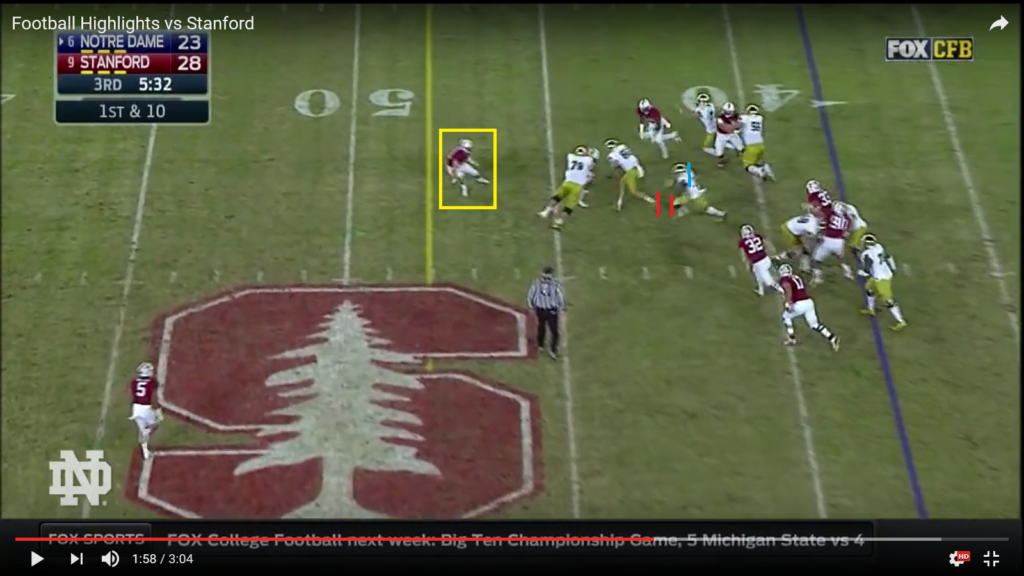
You can see how close Adams is to the blocker (red lines). Even more impressive is that Adams hasn’t yet fully told the defense which direction he is going; his shoulders are still relatively square (blue line). This puts the safety in a very difficult position as he is unsure which direction Adams is heading (yellow box). As a result, the safety has pretty much stopped his feet in anticipation of a change of direction, while Adams is almost in a full sprint. Advantage Notre Dame.
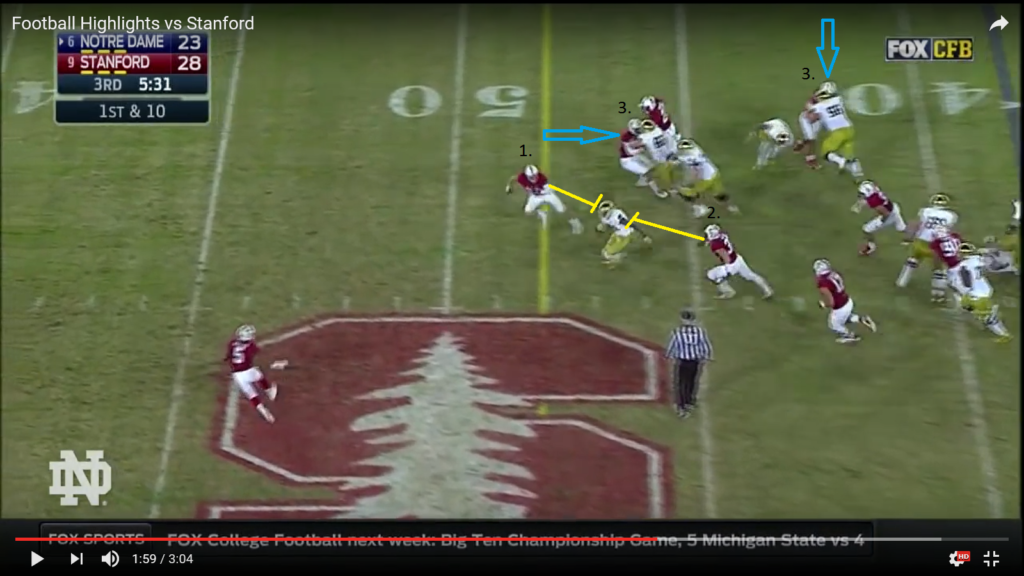
This screen shot represents the confluence of the intellectual and physical elements. Smart running by Adams meant that the safety (labelled 1.) had to wait to figure out which way the play was going. This hesitation provides a little extra breathing room (yellow line). Remember the outside linebacker that initially stayed home for the sweep before pursuing? Well there he is (labelled 2.) The hesitation created by careful play design provides Adams with a little more room (yellow line) on the other side. Finally, if you like a little brawn to go along with your brains, check out Nic Weishar and Quenton Nelson (blue arrows, labelled 3). Weishar is pancaking his man while Nelson is busy driving his man into the next zip code.
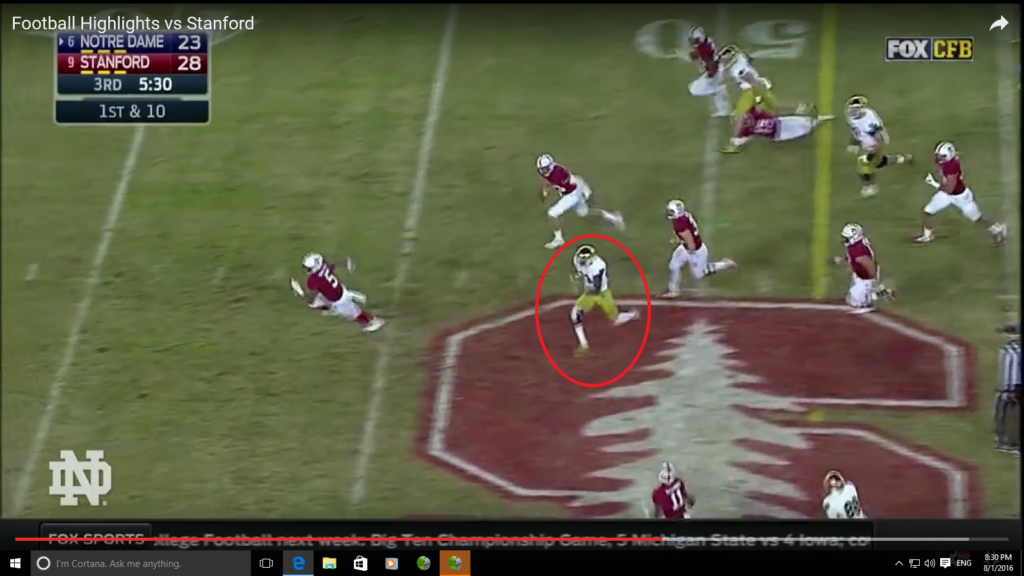
Now it’s time for the physical element. Josh Adams (red circle) is about to out run everyone. It’s nice to have good athletes.
GIF
Final Thoughts
This play demonstrates how physical and intellectual elements intersect to create success on the field. From an intellectual perspective, the play was called at the right time, against the right defense. More importantly, the design of the play pulled four defenders away from the ball carrier which created an opening that could be exploited as the play developed. The running back resisted the temptation to rely solely on his athletic ability. Instead he used his brain and was patient. This allowed his blockers to get into position and forced a potential tackler to slow down, which created a seam he could exploit. Finally, the Notre Dame players won the physical battles. The blockers made their blocks and the running back out ran the tacklers.
It really is a beautiful thing when the intellectual and physical elements combine on the field. Hopefully we see a lot of this combination in 2016.

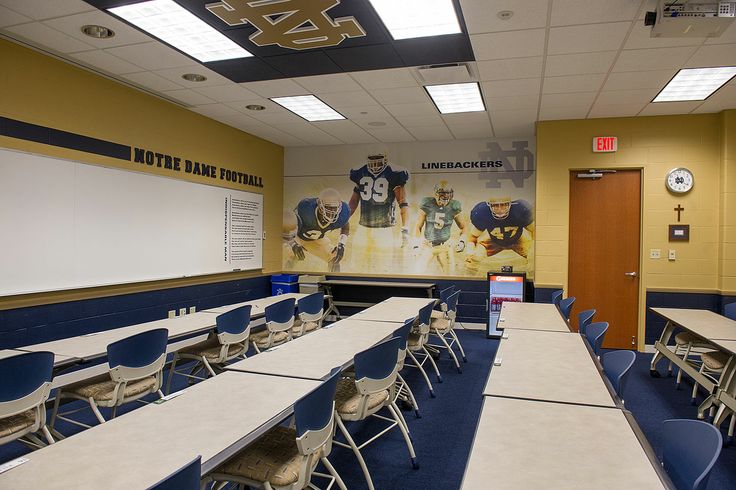

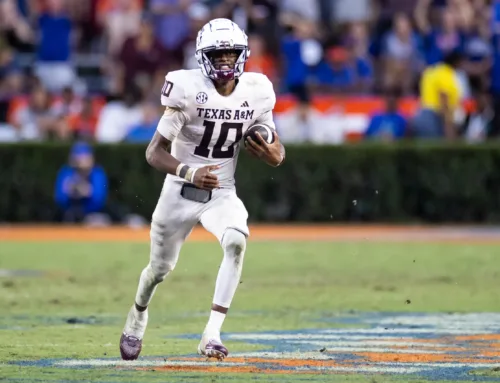


This why coaches knit pick on what seems to be minutia in practice. Things such as, “The key from a running back perspective is to keep your shoulders facing the sidelines (red line) until a seam opens up.” I’m sure this was drilled into Adams at some point. Maybe in practice, “Do it again!” or maybe Adams just needed to see it on film to “get it”. When you’re a coach, you can never know if a player really gets it until game time. It’s what keeps them up all hours watching film and gives them ulcers.
Those of us old enough remember tales of Lombardi believing the Green Bay sweep was unstoppable, if it were run to perfection.
Absolutely tlndma, in some ways, this is simply a re-tooled version of the old sweep play. the details matter for sure
It’s great to see more Canadian writing in here. Great article Larz. I love the play breakdowns. Maybe, we could see a combination of one good/one bad play on both offense and defense.
Thanks RK, that’s a great idea for a post, sort of a compare and contrast. I like it!
Great post Larz! You really see Adams’ speed as he pulls away from the defense.
That backside safety (#5) also had some problems on that play. He overpursued, got turned around, and then got torched Adoree Jackson-style to the endzone.
Thanks Burgs. Yeah, not a great play for the backside safety!
We should add “getting the Adoree Jackson treatment” to the Lexicon as synonymous with getting burned on a play.
I think that is inviting bad juju (Smith-Schuster even).
I could see some of our DBs getting that treatment this year from SC and we don’t have Fuller to return the favor.
He got some help from Stanley but that’s a heartening physical flapjack served up by Weishar.
I was just thinking, man that poor linebacker. He’s like “ok, this sucks, but getting manhandled by an ND offensive lineman is nothing to be embarrassed about” before immediately just being steamrolled by a full speed ahead Weishar. I probably would just call it a day and come back out next Saturday after that.
I think it was Elmer, but the point stands, the O-lines set him up and Weisahr knocked him down.
Should the safety #5 have anticipated the possibility and headed in the direction that Adams ran after the cut rather than pursue toward the sidelines? It seems like there were three guys with a chance to make the tackle had he run for the sideline and wide open space in the direction he actually ran. In other words, for that player, was taking an angle to the sideline the right decision? Or was it his job to fill in some of that open space?
And i took too long to type lol, thanks burger!
Yeah it was a poor angle, but I think you raise a good point dannan14, I think the backside safety might have anticipated Adams running it to the outside away from him and was surprised when Adams cut back…. and of course speed helps.
Along that “surprise” angle… There were a few plays last year where I thought our guy’s speed surprised a defender who should’ve been able to bring him down. In this play, right when Adams breaks it, #11 comes in from the offense’s left and should’ve had an easy (I say from my armchair) dive tackle to take him down – he has to be within 2-3 feet of Adams at that point. I don’t know if he was just straight surprised, or if he thought he’d catch up and try to punch the ball out or something, but Adams just dusted him.
Another one that jumped out was when I was watching Kizer highlights the other day – it was one of the simple crossing patterns against Clemson that turned into a big gain. Kizer hit Chris Brown wide open over the middle, and Brown took it up the sideline. There was a point where he shot between two defenders in phone-booth-level space and somehow both just swiped at him – I think he burst right as he got there and they were surprised. I haven’t seen that happen with ND players in a while, looks kind of nice.
So, assuming team speed will continue to be an asset, which I think is a safe assumption at this point… Is the surprise element something that fast guys do to you, or do you think it’s because other people aren’t used to seeing that from the Irish either and they’ll adjust? And if they do adjust, I would imagine that could sometimes lead to overanxiousness that gets you in just as much trouble. Good problem to have for an offense. Speed kills, man.
I think that it must be what fast people do to you because I find it difficult to believe that when athletes are making unconscious split second judgments about how fast to run they are able to think about the general team speed of the Irish or anyone. Rather they react according to what they are used to from people – i.e. what they normally experience. A really fast person is not a normal experience and so it catches the defender off guard (this is assuming that it did catch the defender off guard and trying to think about why).
It’s a really interesting question, I don’t think anyone expects a freshman to out run them. I would agree with IC23, fast players just do this sometimes, they out run the angles of the defense. And it usually happens after some sort of change of direction, because the fast player can simply accelerate faster. For me that’s what is so impressive about this play from Adams, he moves pretty fast throughout the whole play and then just explodes. Regardless, it’s nice to see ND with athletes that can do this!
Larz, you do such a great job bringing out the subtleties in the plays you break down. The point about Adams’ staying squared up to the perimeter helping Nelson gain the advantage on his guy was like a revelation.
Thanks TGGS! Originally I was going to do this as an Iso Cam on Josh Adams, you know, look at Josh, he made a nice cut and is fast and he’s going to do good next year if he keeps this up type of thing.
As I watched the play a couple of times I said, whoa, there is more to this play. Nelson was definitely one of those guys that jumped out. To come all the way across the formation like that, have the body control to make the block and then maul the defender is pretty good. It was neat to watch how what Adams did a and what Nelson did were so connected. Those are two very good football players.
why don’t we just run the touchdown play every time?
My recollection of Stanford is that we darn near did and still managed to lose the game somehow.
Sad but true
Bravo Larz. You’re getting me fired up for some that that great
OFD18S analysis we get from you guys during the season.Thanks FTQ!
Much of what you mention about Adams’ instructions (stretch the play towards the sidelines, make a cut at the right time instead of heading straight for the open field, etc) reminds me so much of what my high school coaches used to drill into our running backs’ heads.
Even though we ran the ball about 95% of the time (and that’s a low-ball estimate) we absolutely lit up the scoreboard — averaged about 40 points per game. I think that kind of coaching (along with a highly deceptive offensive scheme) is probably what made us so effective, despite the fact that literally nobody on the team was particularly fast, shifty, or otherwise dangerous with the ball in their hands.
Totally agree Tyler. A good game plan and excellent execution goes a long way.
Hi Larz,
It’s fantastique to see your analysis again – took me a month or so to figure out how to register, but for whatever it’s worth – France is back!
To your point above, first in a general way: when my older son left his Paris suburb soccer team at 16 because the ambience had just gotten too nasty, too pre-professional as most of the other kids were desperately trying to use soccer as a way to upward mobility, he joined the Paris region American football league. He start at corner back for a couple of years prior to attending ND; and the first thing he told me was exactly what you are saying: that American football is really a crazy mix of violence, speed… and sheer hard intellectual work.
Second, echoing the above, in view of how much BVG has been criticized for overly complex defenses, I am wondering if you could run an analysis of a defensive play that worked because of its complexity — and one that looked like it failed because of the same?
I think this could be most instructive as we wait to see how the defense looks in year 3 of the BVG era.
Anyway, delighted to have found you guys again!
Hi M.N.!
Always great to hear from you! I hope things are going well.
Football really is a mix of all those things, that’s one of the aspects of the game that I absolutely love. As for the post, that’s a great idea, I’ve done some posts on successful plays from BVG and not so successful, but I’ve never done both together as a compare and contrast. I’ll see if I can come up with something!